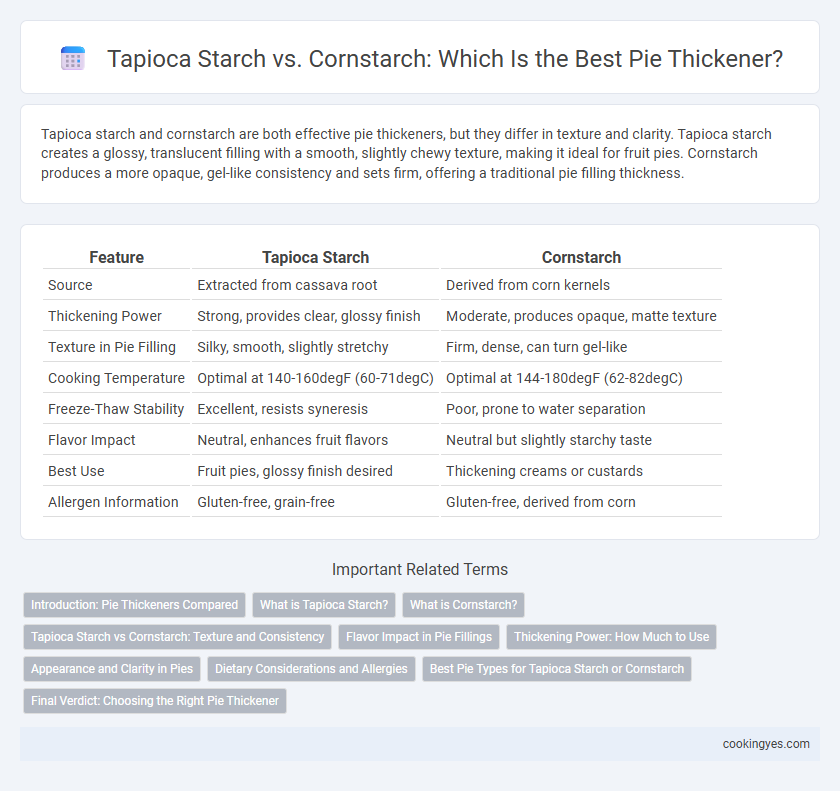Tapioca starch and cornstarch are both effective pie thickeners, but they differ in texture and clarity. Tapioca starch creates a glossy, translucent filling with a smooth, slightly chewy texture, making it ideal for fruit pies. Cornstarch produces a more opaque, gel-like consistency and sets firm, offering a traditional pie filling thickness.
Table of Comparison
| Feature | Tapioca Starch | Cornstarch |
|---|---|---|
| Source | Extracted from cassava root | Derived from corn kernels |
| Thickening Power | Strong, provides clear, glossy finish | Moderate, produces opaque, matte texture |
| Texture in Pie Filling | Silky, smooth, slightly stretchy | Firm, dense, can turn gel-like |
| Cooking Temperature | Optimal at 140-160degF (60-71degC) | Optimal at 144-180degF (62-82degC) |
| Freeze-Thaw Stability | Excellent, resists syneresis | Poor, prone to water separation |
| Flavor Impact | Neutral, enhances fruit flavors | Neutral but slightly starchy taste |
| Best Use | Fruit pies, glossy finish desired | Thickening creams or custards |
| Allergen Information | Gluten-free, grain-free | Gluten-free, derived from corn |
Introduction: Pie Thickeners Compared
Tapioca starch and cornstarch are popular thickening agents in pie making, each offering unique properties that impact texture and clarity. Tapioca starch yields a glossy, translucent filling with a smoother, stretchier consistency, ideal for fruit pies requiring a clear gel-like finish. Cornstarch produces a denser, more opaque filling with a slightly gelatinous texture, preferred for custard or cream pies where a firmer set is desired.
What is Tapioca Starch?
Tapioca starch, derived from the cassava root, is a fine, white powder used as a natural thickening agent in pies. It offers a clear, glossy finish and a smooth texture, making it ideal for fruit fillings that require a shiny appearance. Compared to cornstarch, tapioca starch provides better freeze-thaw stability and resists breaking down during prolonged cooking, resulting in a more consistent filling.
What is Cornstarch?
Cornstarch is a fine, white powder derived from the endosperm of corn kernels, commonly used as a thickening agent in pie fillings. It creates a translucent, glossy finish and thickens quickly at lower temperatures compared to tapioca starch. Cornstarch is ideal for fruit pies with juicy fillings, providing a smooth texture without altering the flavor.
Tapioca Starch vs Cornstarch: Texture and Consistency
Tapioca starch creates a clear, glossy finish with a smooth, elastic texture that holds well in both freezing and thawing processes, making it ideal for fruit pie fillings. Cornstarch produces a more opaque, matte appearance with a slightly firmer, gel-like consistency that can become spongy or watery after reheating or freezing. For pies requiring a stable, consistent texture and shine, tapioca starch outperforms cornstarch in maintaining quality and mouthfeel.
Flavor Impact in Pie Fillings
Tapioca starch offers a neutral flavor that preserves the original taste of fruit pie fillings, making it ideal for delicate flavors like berries or apples. Cornstarch can sometimes impart a slightly chalky or starchy taste, which may alter the subtle sweetness and freshness of the filling. For pies where flavor clarity is essential, tapioca starch ensures a clean, pure taste without overshadowing the fruit's natural profile.
Thickening Power: How Much to Use
Tapioca starch has a higher thickening power than cornstarch, requiring less quantity to achieve a similar consistency in pie fillings. Typically, use about half the amount of tapioca starch compared to cornstarch to thicken fruit pies effectively. This means 1 tablespoon of tapioca starch can replace 2 tablespoons of cornstarch, resulting in a clearer, glossy texture without the gummy feel.
Appearance and Clarity in Pies
Tapioca starch creates a clear, glossy filling that enhances the pie's appearance with a smooth, attractive shine, making it ideal for fruit pies where clarity is important. Cornstarch tends to produce a more opaque and matte finish, which can dull the visual appeal of the filling despite effective thickening. For pies requiring a translucent crust-to-filling contrast, tapioca starch offers superior clarity and a more appealing, polished look.
Dietary Considerations and Allergies
Tapioca starch is a gluten-free and grain-free thickener suitable for individuals with wheat allergies or celiac disease, making it a safer choice for those with dietary restrictions. Cornstarch, derived from corn, may trigger reactions in people with corn allergies and is also gluten-free but less suitable for grain-free diets. Both starches provide effective thickening for pies, but tapioca starch offers a more hypoallergenic profile for sensitive or restrictive diets.
Best Pie Types for Tapioca Starch or Cornstarch
Tapioca starch excels as a thickener in fruit pies with high moisture content like berry or cherry pies, providing a clear, glossy finish and preventing the filling from becoming overly gelled. Cornstarch is ideal for creamy pies and custards such as lemon meringue or pumpkin pie, offering a smooth texture with a slightly opaque appearance and reliable thickening power. Choosing tapioca starch enhances pies needing a stable, flexible consistency, while cornstarch is preferred for richer, denser pie fillings.
Final Verdict: Choosing the Right Pie Thickener
Tapioca starch provides a glossy, clear finish and resists breaking down during freezing, making it ideal for fruit pies that require a stable, long-lasting thickener. Cornstarch offers a more opaque, matte appearance and thickens quickly but can break down after reheating or freezing, best suited for pies eaten fresh. For a pie thickener that maintains texture and clarity in frozen or refrigerated desserts, tapioca starch is the superior choice; cornstarch works well for immediate serving with a smooth, firm consistency.
Tapioca starch vs Cornstarch for pie thickener Infographic

 cookingyes.com
cookingyes.com